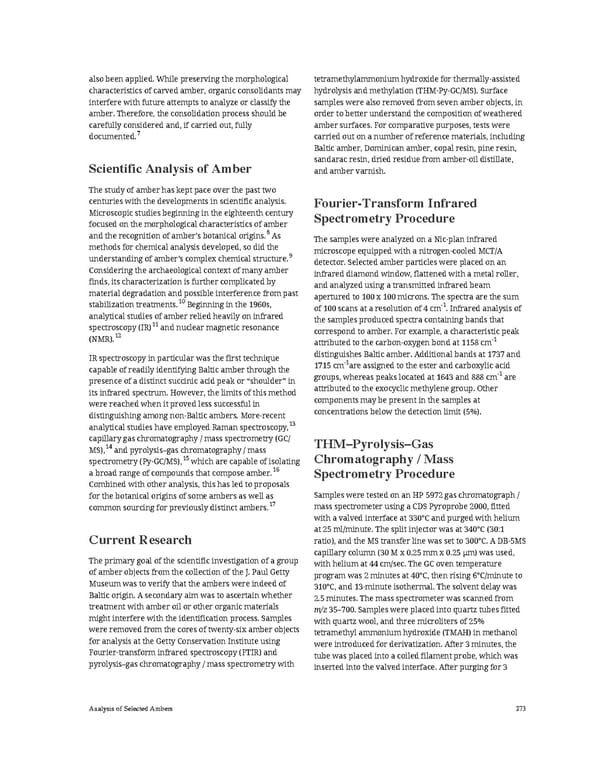also been applied. While preserving the morphological tetramethylammonium hydroxide for thermally-assisted characteristics of carved amber, organic consolidants may hydrolysis and methylation (THM-Py-GC/MS). Surface interfere with future attempts to analyze or classify the samples were also removed from seven amber objects, in amber. Therefore, the consolidation process should be order to better understand the composition of weathered carefully considered and, if carried out, fully amber surfaces. For comparative purposes, tests were documented.7 carried out on a number of reference materials, including Baltic amber, Dominican amber, copal resin, pine resin, Scientific Analysis of Amber sandarac resin, dried residue from amber-oil distillate, and amber varnish. The study of amber has kept pace over the past two centuries with the developments in scientific analysis. Fourier-Transform Infrared Microscopic studies beginning in the eighteenth century Spectrometry Procedure focused on the morphological characteristics of amber and the recognition of amber’s botanical origins.8 As The samples were analyzed on a Nic-plan infrared methods for chemical analysis developed, so did the microscope equipped with a nitrogen-cooled MCT/A understanding of amber’s complex chemical structure.9 detector. Selected amber particles were placed on an Considering the archaeological context of many amber infrared diamond window, flattened with a metal roller, finds, its characterization is further complicated by and analyzed using a transmitted infrared beam material degradation and possible interference from past apertured to 100 x 100 microns. The spectra are the sum stabilization treatments.10 Beginning in the 1960s, -1 of 100 scans at a resolution of 4 cm . Infrared analysis of analytical studies of amber relied heavily on infrared the samples produced spectra containing bands that spectroscopy (IR)11 and nuclear magnetic resonance 12 correspond to amber. For example, a characteristic peak (NMR). attributed to the carbon-oxygen bond at 1158 cm-1 IR spectroscopy in particular was the first technique distinguishes Baltic amber. Additional bands at 1737 and 1715 cm-1are assigned to the ester and carboxylic acid capable of readily identifying Baltic amber through the groups, whereas peaks located at 1643 and 888 cm-1 are presence of a distinct succinic acid peak or “shoulder” in attributed to the exocyclic methylene group. Other its infrared spectrum. However, the limits of this method components may be present in the samples at were reached when it proved less successful in concentrations below the detection limit (5%). distinguishing among non-Baltic ambers. More-recent analytical studies have employed Raman spectroscopy,13 capillary gas chromatography / mass spectrometry (GC/ THM–Pyrolysis–Gas MS),14 and pyrolysis–gas chromatography / mass spectrometry (Py-GC/MS),15 which are capable of isolating Chromatography / Mass a broad range of compounds that compose amber.16 Spectrometry Procedure Combined with other analysis, this has led to proposals for the botanical origins of some ambers as well as Samples were tested on an HP 5972 gas chromatograph / common sourcing for previously distinct ambers.17 mass spectrometer using a CDS Pyroprobe 2000, fitted with a valved interface at 330°C and purged with helium at 25 ml/minute. The split injector was at 340°C (30:1 Current Research ratio), and the MS transfer line was set to 300°C. A DB-5MS capillary column (30 M x 0.25 mm x 0.25 µm) was used, The primary goal of the scientific investigation of a group with helium at 44 cm/sec. The GC oven temperature of amber objects from the collection of the J. Paul Getty program was 2 minutes at 40°C, then rising 6°C/minute to Museum was to verify that the ambers were indeed of 310°C, and 13-minute isothermal. The solvent delay was Baltic origin. A secondary aim was to ascertain whether 2.5 minutes. The mass spectrometer was scanned from treatment with amber oil or other organic materials m/z35–700. Samples were placed into quartz tubes fitted might interfere with the identification process. Samples with quartz wool, and three microliters of 25% were removed from the cores of twenty-six amber objects tetramethyl ammonium hydroxide (TMAH) in methanol for analysis at the Getty Conservation Institute using were introduced for derivatization. After 3 minutes, the Fourier-transform infrared spectroscopy (FTIR) and tube was placed into a coiled filament probe, which was pyrolysis–gas chromatography / mass spectrometry with inserted into the valved interface. After purging for 3 Analysis of Selected Ambers 273
 Ancient Carved Ambers in the J. Paul Getty Museum Page 282 Page 284
Ancient Carved Ambers in the J. Paul Getty Museum Page 282 Page 284